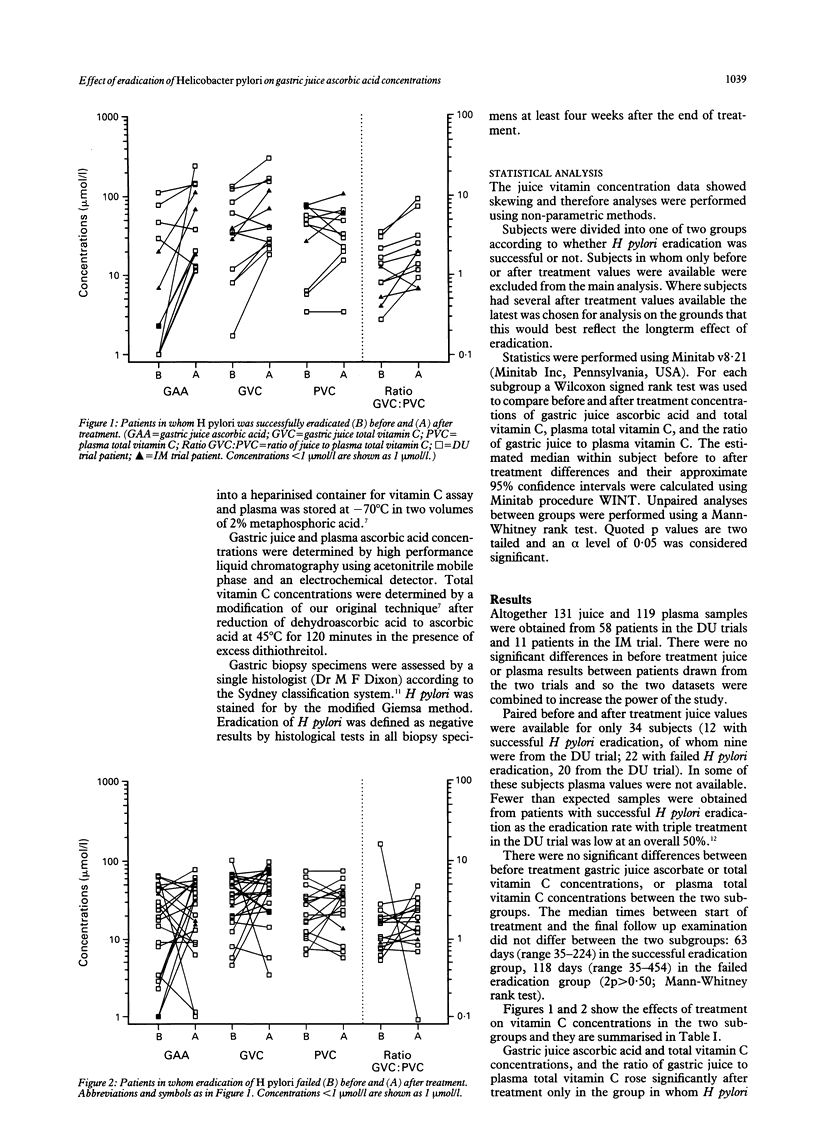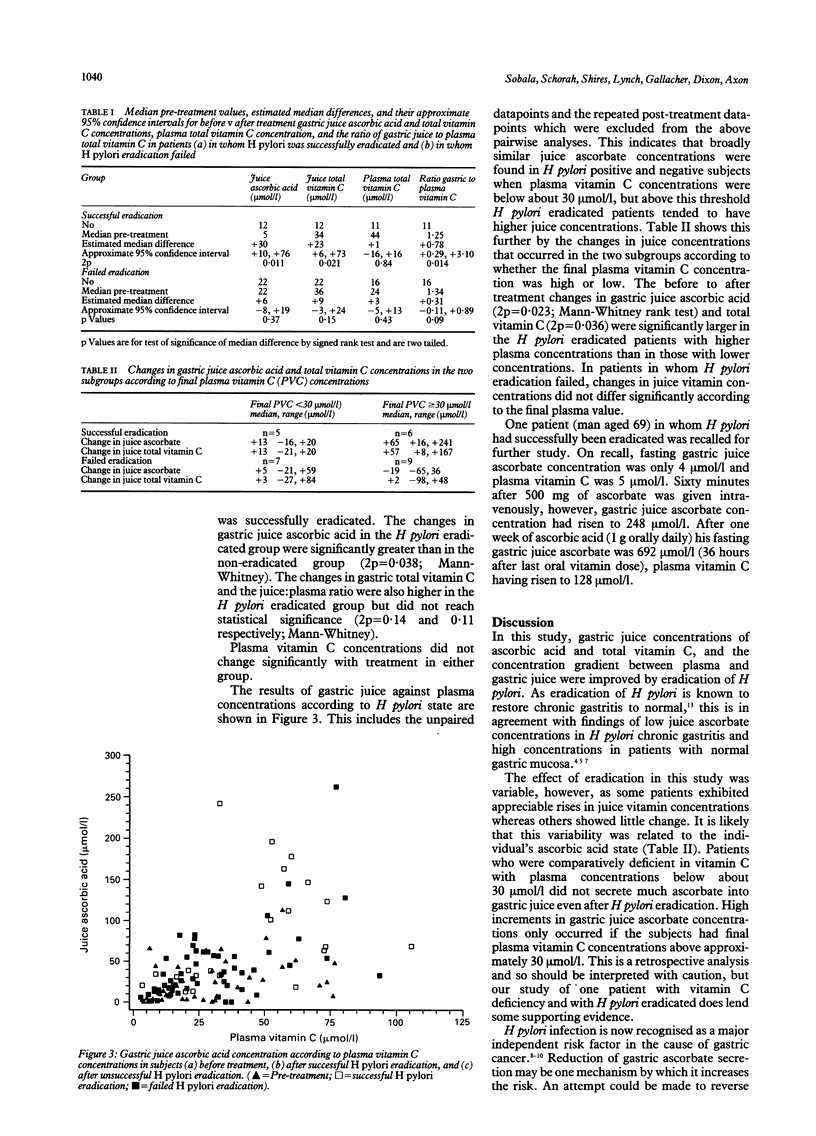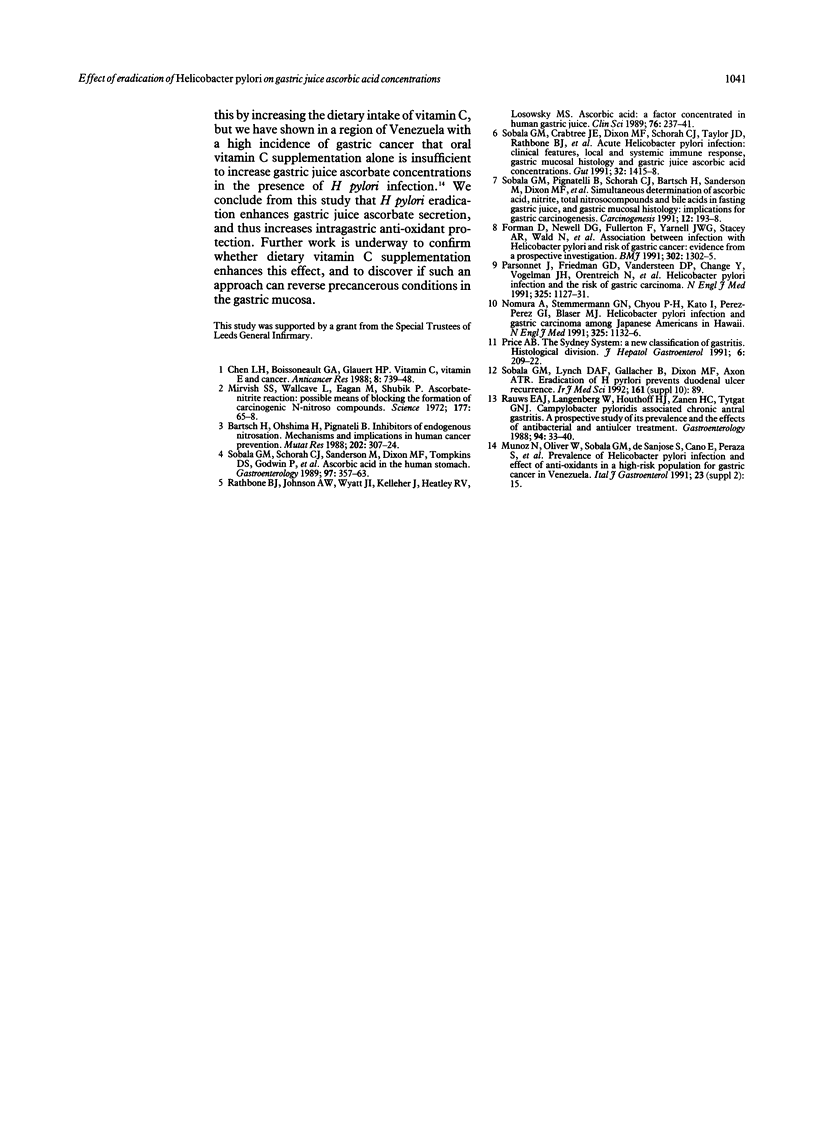Abstract
Ascorbic acid, the reduced form of vitamin C, may protect against gastric cancer and is secreted by the normal stomach. Secretion is impaired in Helicobacter pylori (H pylori) associated chronic gastritis. This study examined if eradication of H pylori improves gastric juice ascorbate values. Fasting gastric juice and plasma samples were collected at endoscopy from patients participating in trials of H pylori eradication for duodenal ulcer disease and intestinal metaplasia before and up to 15 months after attempted eradication. Ascorbic acid and total vitamin C concentrations were determined by high performance liquid chromatography. In 12 patients in whom H pylori was successfully eradicated gastric juice ascorbate and total vitamin C concentrations and the ratio of juice to plasma vitamin C rose after treatment. Analysis after treatment suggested that the rise was greatest in patients with high final plasma vitamin C concentrations, even though these did not change with treatment. By contrast, in 22 patients in whom H pylori eradication was unsuccessful there were no significant changes in juice or plasma concentrations after treatment. It is concluded that successful eradication of H pylori improves secretion of vitamin C into gastric juice. It is speculated that this increases protection against gastric cancer.
Full text
PDF



Selected References
These references are in PubMed. This may not be the complete list of references from this article.
- Bartsch H., Ohshima H., Pignatelli B. Inhibitors of endogenous nitrosation. Mechanisms and implications in human cancer prevention. Mutat Res. 1988 Dec;202(2):307–324. doi: 10.1016/0027-5107(88)90194-7. [DOI] [PubMed] [Google Scholar]
- Chen L. H., Boissonneault G. A., Glauert H. P. Vitamin C, vitamin E and cancer (review). Anticancer Res. 1988 Jul-Aug;8(4):739–748. [PubMed] [Google Scholar]
- Forman D., Newell D. G., Fullerton F., Yarnell J. W., Stacey A. R., Wald N., Sitas F. Association between infection with Helicobacter pylori and risk of gastric cancer: evidence from a prospective investigation. BMJ. 1991 Jun 1;302(6788):1302–1305. doi: 10.1136/bmj.302.6788.1302. [DOI] [PMC free article] [PubMed] [Google Scholar]
- Mirvish S. S., Wallcave L., Eagen M., Shubik P. Ascorbate-nitrite reaction: possible means of blocking the formation of carcinogenic N-nitroso compounds. Science. 1972 Jul 7;177(4043):65–68. doi: 10.1126/science.177.4043.65. [DOI] [PubMed] [Google Scholar]
- Nomura A., Stemmermann G. N., Chyou P. H., Kato I., Perez-Perez G. I., Blaser M. J. Helicobacter pylori infection and gastric carcinoma among Japanese Americans in Hawaii. N Engl J Med. 1991 Oct 17;325(16):1132–1136. doi: 10.1056/NEJM199110173251604. [DOI] [PubMed] [Google Scholar]
- Parsonnet J., Friedman G. D., Vandersteen D. P., Chang Y., Vogelman J. H., Orentreich N., Sibley R. K. Helicobacter pylori infection and the risk of gastric carcinoma. N Engl J Med. 1991 Oct 17;325(16):1127–1131. doi: 10.1056/NEJM199110173251603. [DOI] [PubMed] [Google Scholar]
- Price A. B. The Sydney System: histological division. J Gastroenterol Hepatol. 1991 May-Jun;6(3):209–222. doi: 10.1111/j.1440-1746.1991.tb01468.x. [DOI] [PubMed] [Google Scholar]
- Rathbone B. J., Johnson A. W., Wyatt J. I., Kelleher J., Heatley R. V., Losowsky M. S. Ascorbic acid: a factor concentrated in human gastric juice. Clin Sci (Lond) 1989 Mar;76(3):237–241. doi: 10.1042/cs0760237. [DOI] [PubMed] [Google Scholar]
- Rauws E. A., Langenberg W., Houthoff H. J., Zanen H. C., Tytgat G. N. Campylobacter pyloridis-associated chronic active antral gastritis. A prospective study of its prevalence and the effects of antibacterial and antiulcer treatment. Gastroenterology. 1988 Jan;94(1):33–40. [PubMed] [Google Scholar]
- Sobala G. M., Crabtree J. E., Dixon M. F., Schorah C. J., Taylor J. D., Rathbone B. J., Heatley R. V., Axon A. T. Acute Helicobacter pylori infection: clinical features, local and systemic immune response, gastric mucosal histology, and gastric juice ascorbic acid concentrations. Gut. 1991 Nov;32(11):1415–1418. doi: 10.1136/gut.32.11.1415. [DOI] [PMC free article] [PubMed] [Google Scholar]
- Sobala G. M., Pignatelli B., Schorah C. J., Bartsch H., Sanderson M., Dixon M. F., Shires S., King R. F., Axon A. T. Levels of nitrite, nitrate, N-nitroso compounds, ascorbic acid and total bile acids in gastric juice of patients with and without precancerous conditions of the stomach. Carcinogenesis. 1991 Feb;12(2):193–198. doi: 10.1093/carcin/12.2.193. [DOI] [PubMed] [Google Scholar]
- Sobala G. M., Schorah C. J., Sanderson M., Dixon M. F., Tompkins D. S., Godwin P., Axon A. T. Ascorbic acid in the human stomach. Gastroenterology. 1989 Aug;97(2):357–363. doi: 10.1016/0016-5085(89)90071-1. [DOI] [PubMed] [Google Scholar]


